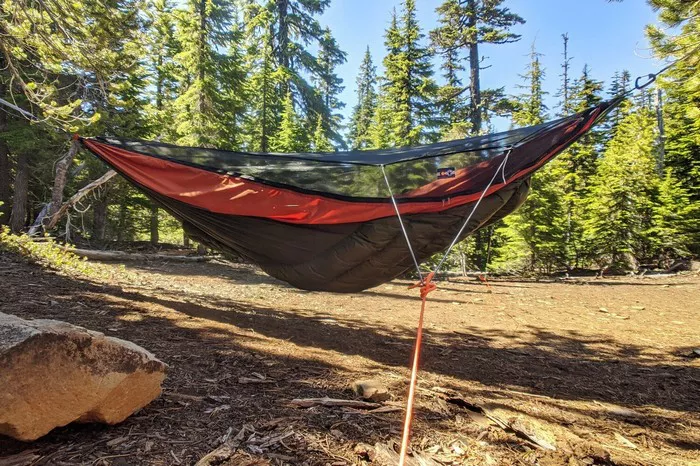Hammock camping offers outdoor enthusiasts a unique and exhilarating way to experience the great outdoors. With the right gear and knowledge, you can enjoy a comfortable night’s sleep suspended between two trees, away from the damp ground and critters that might roam beneath a traditional tent. In this comprehensive guide, we’ll walk you through everything you need to know to embark on your hammock camping adventure, from selecting the right gear to mastering the art of a good night’s sleep.
Essential Gear for Hammock Camping
Before you head out into the wilderness, it’s crucial to ensure you have the right gear to make your hammock camping trip a success. Here’s a detailed list of the essential equipment you’ll need:
1. Hammock: The centerpiece of your setup, a quality hammock is essential for a comfortable night’s sleep. Look for hammocks made from durable, breathable materials, and consider options with built-in bug nets or rain flies for added protection.
2. Suspension System: To hang your hammock securely between two trees, you’ll need a reliable suspension system. Options range from simple straps to more advanced systems with adjustable buckles, carabiners, and tree-friendly straps to minimize environmental impact.
3. Tarps: Protect yourself from the elements with a sturdy tarp or rain fly. Choose a size that provides ample coverage for your hammock and offers protection from rain, wind, and sun exposure.
4. Insulation: Unlike sleeping on the ground in a tent, hammock campers need to consider insulation to stay warm during colder nights. This can include underquilts, sleeping pads, or insulated sleeping bags designed specifically for hammock camping.
5. Accessories: Consider additional accessories such as gear organizers, ridgelines, or underquilt protectors to enhance your hammock camping experience and keep your gear organized and protected.
Tips for a Comfortable Night’s Sleep in a Hammock
While hammock camping offers many advantages, such as elevated sleeping and increased ventilation, it also comes with its own set of challenges. Here are some tips to ensure you enjoy a comfortable night’s sleep in your hammock:
1. Find the Right Sleeping Position: Experiment with different sleeping positions to find what works best for you. Some campers prefer lying flat, while others find a slight diagonal position more comfortable.
2. Use Proper Insulation: Prevent cold spots and ensure a warm night’s sleep by using adequate insulation. Underquilts are especially effective at trapping body heat and preventing heat loss to the cool night air below.
3. Adjust Your Suspension: Achieve the perfect sag in your hammock by adjusting your suspension system. A hammock that’s too tight can cause discomfort, while one that’s too loose may lead to back strain.
4. Stay Organized: Keep essential items within reach by using gear organizers or pouches attached to your hammock’s ridgeline. This ensures you can easily access items like a headlamp, water bottle, or snacks without having to get out of your hammock.
5. Practice Leave No Trace Principles: Minimize your environmental impact by following Leave No Trace principles. Choose durable anchor points for your hammock, pack out all waste, and avoid damaging vegetation when setting up camp.
Hammock Camping vs Tent Camping
Both hammock camping and tent camping offer unique experiences, each with its own set of advantages and disadvantages. Here’s a comparison to help you decide which option is right for your next outdoor adventure:
Advantages of Hammock Camping:
- Elevated sleeping position reduces pressure points and promotes better blood circulation.
- Minimal impact on the environment, as hammocks can be set up without disturbing the ground or vegetation.
- Versatility in terrain, allowing you to camp in areas where traditional tents might not be feasible, such as rocky terrain or steep slopes.
Disadvantages of Hammock Camping:
- Requires trees or sturdy anchor points for setup, limiting camping options in treeless environments.
- Additional insulation may be necessary in colder temperatures to stay warm.
- Limited interior space compared to a tent, which may be less comfortable during extended periods of rain or inclement weather.
Advantages of Tent Camping:
- Greater interior space and headroom, providing more comfort during extended periods of time spent inside the shelter.
- Suitable for a wider range of environments, including treeless areas or locations with limited anchor points.
- Easier to set up in windy or exposed conditions, as tents offer a more stable shelter option.
Disadvantages of Tent Camping:
- Susceptible to ground moisture, requiring additional precautions such as ground tarps or waterproofing treatments.
- Increased environmental impact, as tents can damage vegetation and leave more visible traces of camping activity.
- Potential for discomfort due to uneven or rocky ground, especially without the use of a sleeping pad or inflatable mattress.
Conclusion
In conclusion, both hammock camping and tent camping offer unique advantages and disadvantages, and the best option for you will depend on your personal preferences, camping style, and environmental considerations. Whether you choose to sway gently in a hammock beneath the stars or hunker down in a cozy tent, the most important thing is to get outside and enjoy the beauty of nature responsibly. Happy camping!

